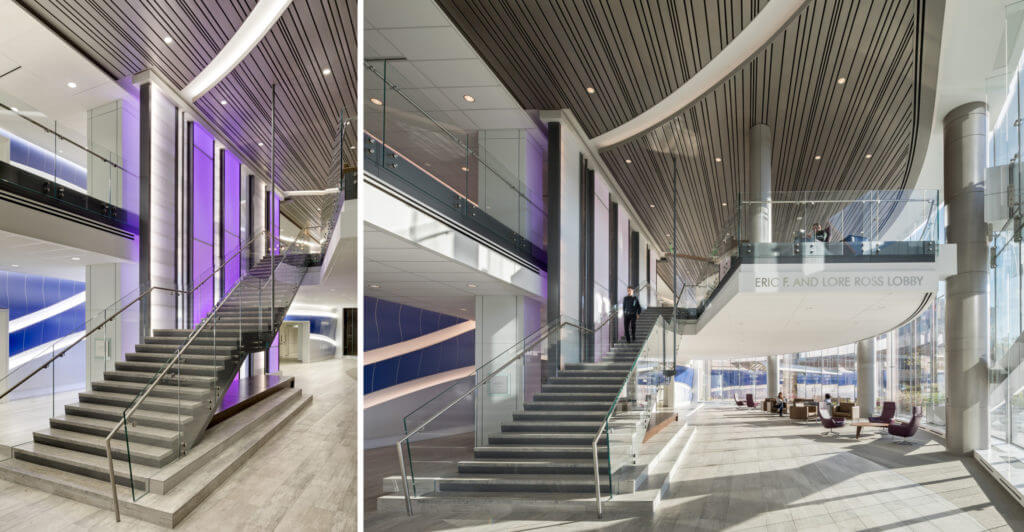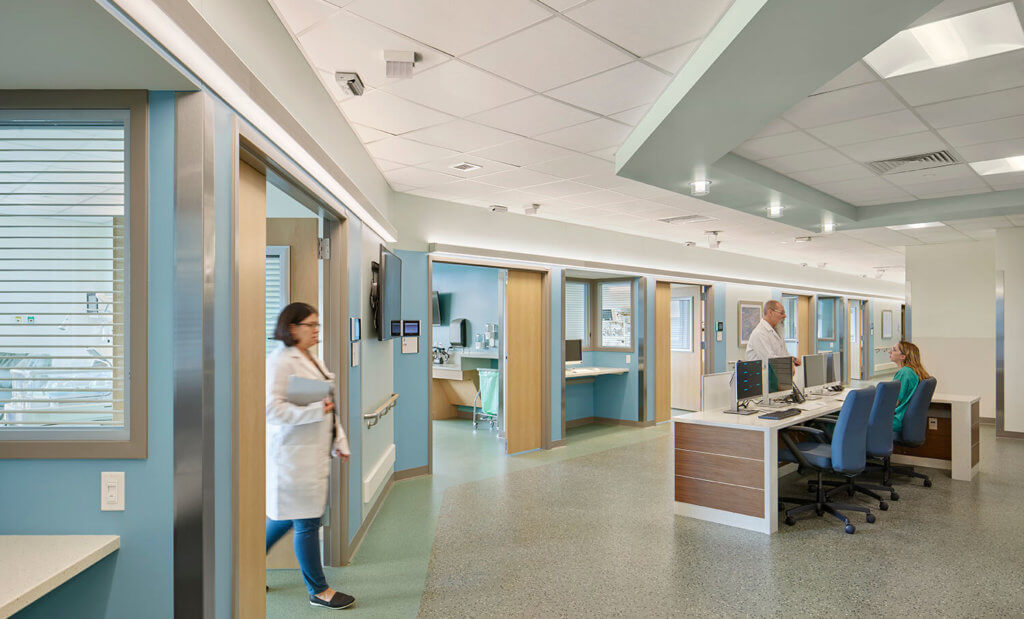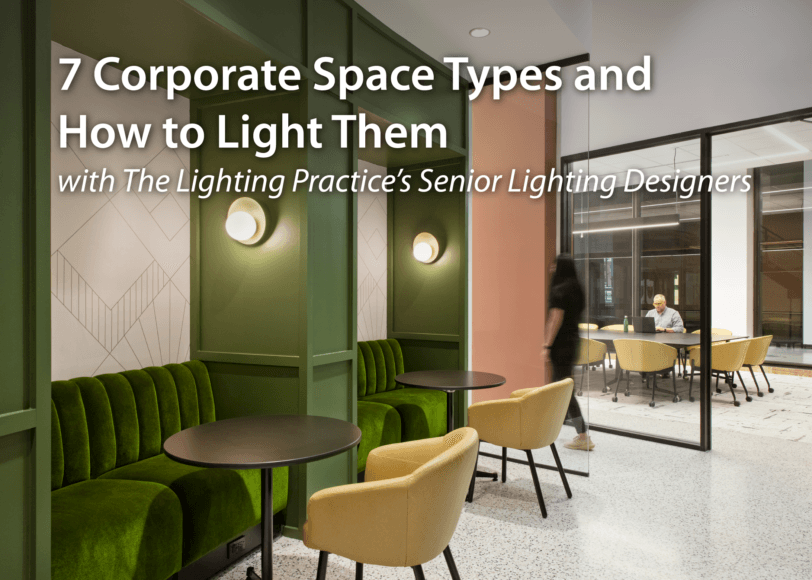Healthcare design often focuses on patient outcomes, but healthcare lighting design also needs to support the doctors, nurses and staff who work in these environments consistently for extended periods of time. Michael Barber, Associate IALD, LEED AP BD+C, Principal, and Caitlin Bucari, Senior Lighting Designer, weigh in on how to support the behavioral, mental and physical well-being of healthcare workers through lighting design.
“When we design a healthcare facility, as lighting design professionals we’re concerned not just with patient outcomes, but also with the people working 10- or 12-hour days in the space,” shares Michael Barber, Associate IALD, LEED AP, Principal at the Lighting Practice. For Michael, whose wife and daughter are both registered nurses, it’s an approach that stems from a deep personal connection to the healthcare field. “I love working on healthcare projects because we can make a real difference to staff, patients, visitors, and anyone who comes into a healthcare environment.”
Likewise for Caitlin Bucari, Senior Lighting Designer, whose mother-in-law spent decades working in a hospital lab. “It’s rewarding to make a stressful environment feel more comfortable, like a hotel stay rather than a clinical visit.”
The stakes are high for designing better spaces for healthcare shift workers. A growing number of organizations, including the American Association of Cancer Research, have published studies indicating an association between long-term shift work and cancer risk. Female shift workers in particular are at higher risk for breast cancer and lung cancer. While lighting isn’t the only factor affecting the health of shift workers, good lighting design can help provide a more comfortable, productive environment for healthcare workers.
As lighting designers with an extensive background in healthcare projects, Michael and Caitlin share some keys ways in which lighting design make an impact on healthcare workers.
Controllability
Flexibility and ease of control are the most common requests from healthcare staff when it comes to lighting. “Staff don’t want to have to fuss with lighting or learn new systems. They want intuitive controls so they can quickly and easily transition the lighting as they move from room to room,” says Caitlin.
The best approach often involves designing optimal lighting schemes that can accommodate individual needs and preferences. “There’s certainly a balance between creating flexibility that staff wants and also providing consistency,” she continues. “We set standards to create most comfortable environments for all staff. But if the lighting is over-automated, staff feel like they have no control.”
The ability to adjust lighting can make a big difference when it comes to not only productivity, but the well-being of healthcare workers.
“At night, nurses may have to work, but they still get tired,” shares Michael. “Flexibility, layers of light, and controllability of light sources allows healthcare workers to feel more comfortable but still be productive.” The ability to dim the lights can also make an environment less intense and help calm people down, which is key in a healthcare setting.

For the Cooperman Family Pavilion at Saint Barnabas Medical Center in Livingston, NJ, The Lighting Practice team developed a lighting system that allows individual users to fine tune the lighting levels to their own preferences without disrupting the preset functions – striking a good balance between controllability and practicality. Photo by Chris Cooper.
Access to Natural Light
Healthcare architectural design has evolved so that transient spaces, such as lobbies and waiting areas, are often placed along the window-lined perimeter of a building, while staff and administrative areas are typically pulled towards the building’s center with limited or no access to daylight. This presents a challenge for healthcare workers spending long days in areas devoid of natural light.
“Even with all the advances in LED and other technology, there is no substitute for natural light,” comments Michael. “Our bodies depend on the sunrise and sunset to maintain our natural rhythm, which affects our hormones.” Architects and designers need to include more access to daylight for healthcare workers, as well as outdoor places of respite for staff.
While electric light isn’t a substitute for daylight, the right approach can help. “Layers of light are what give you options to create a more comfortable space,” says Caitlin. “Having a variety of fixtures like sconces in addition to traditional overhead lighting makes it more comfortable,” especially with limited daylight.
Michael adds, “We’ll use layers of illumination – wall lighting, task lighting, ambient lighting, soft accent lighting – to add controllability and comfort. We’ll include dedicated light sources, for instance, in touch-down data entry stations outside of patient rooms. We’ve even designed ‘naptime’ settings in lighting controls to help both healthcare workers and patients get rest when they need it.”

An integrated project delivery (IPD) approach at Inspira Medical Center in Mullica Hill, New Jersey enabled The Lighting Practice to communicate with the entire project team during the early phases of design. A successful implementation of simple lighting fixtures helped maintain the budget while allowing for plenty of controllability for both staff and patients. Photo by Halkin | Mason.
Be Mindful of Trends
The impact of COVID-19 has led manufacturers to promote products that offer UV sterilization and a wide range of disinfecting fixtures is easily available for purchase. However, Michael and Caitlin urge healthcare systems to be very careful about implementing UV solutions unless in very specifically controlled environments.
“UV-C has been promoted to help combat COVID, and it does kill the virus,” says Michael, “but humans should not be exposed to UV-C. It can be very unsafe if not used in the correct manner.”
Exciting Progress, but “Still a Long Way to Go”
Healthcare design has made significant progress away from institutional aesthetics, and research is underway to improve lighting conditions for healthcare workers. [For example, The Lighting Practice’s design for a national healthcare institution is being studied by researchers to better understand the effect of electric light, specifically color temperatures and intensity levels on healthcare workers]
However, the COVID pandemic has tightened the budget of many healthcare systems, and solutions that offer flexibility and control are often the first items to be cut from the budget. “We still have a long way to go, to be honest,” admits Michael. “The design industry talks a lot about patient outcomes and attraction, but we would like controllability for healthcare workers to be more of a focus.”
As healthcare systems battle for both market share and talent, more thoughtful lighting design can be beneficial for all. Healthcare systems are building and promoting best-in-class facilities to attract patients as well as researchers, doctors and other staff. Flexible, layered lighting that creates a more hospitality-like atmosphere can help make these spaces more desirable – and healthier – for patients and potential talent alike.








